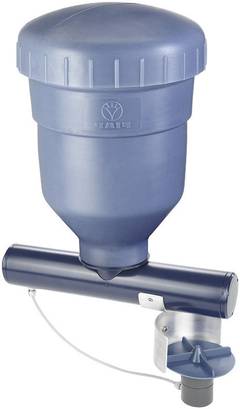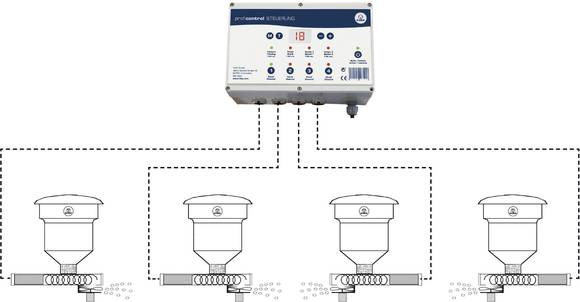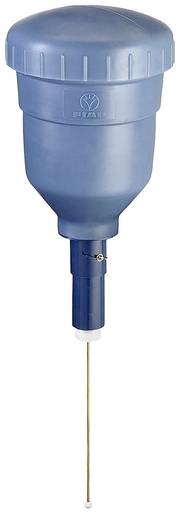Automatic fish feeders » Effective feeding with little effort
Published: 12.08.2021 | Reading time: 5 minutes
This text is machine translated.
Automatic feeders have proven their worth for years in fish farming, pond management and aquariums. This is why these clever feed dispensers are now increasingly being used in ornamental and garden ponds.
However, companies with an attractive pond in front of the company building are also increasingly using this technology. This is because the sometimes very valuable fish stock of koi and co. must of course also be fed as required at weekends and during vacation periods.
We explain the advantages of automatic feeders and tell you what you need to bear in mind when using them.
An automatic fish food dispenser has the task of automatically supplying the fish in a breeding tank, pond or aquarium with food at regular intervals. To do this, the corresponding storage container is filled with a specified amount of fish food, which is then dispensed to the fish in small portions. Depending on the size of the body of water and the number of fish to be fed, the designs and functions of the devices differ.
Because the food supply in the wild is rather limited, most fish are constantly on the lookout for food. They move actively in their habitat and therefore appear agile and fit. For this reason, the food supply in aquariums or garden ponds should also be adapted to the natural behavior of the fish. Instead of feeding a large amount of food once or twice a day, smaller amounts can be fed five or six times a day.
This has the great advantage that the available fish food is completely absorbed and does not sink to the bottom unused. This is because the biological decomposition of unused food residues encourages the formation of harmful substances, which massively deteriorates the water quality. As only the storage container needs to be refilled from time to time, the time and effort required for feeding is significantly reduced. Weekends or even a short vacation can thus be easily bridged. If you are away for a longer period of time, it is perfectly sufficient to simply explain to the vacation replacement that the storage container needs to be refilled.
By precisely specifying the feeding times and quantities, there is also no risk of overfeeding the fish. Unfortunately, inexperienced aquarium and garden pond enthusiasts still make this terrible mistake far too often.
While automatic feeders for aquariums only hold a few grams of feed, an automatic feeder for a fish pond can hold several kilograms. But the control system can also be different.
In a fish farm, where some of the tanks are located indoors, a reliable power supply for the electronic central control system is not an issue. Several automatic machines can often be connected to one central control unit (see example image).
Battery-operated devices are ideal for small and large garden ponds. Mechanical pendulum feeders have proven to be ideal for fish ponds in the wild. Only when a fish touches the pendulum rod and pushes it to the side does the feeder release a few pieces of fish food into the water.
Fish feeders are available in a wide variety of designs. This is because an automatic feeder for an aquarium has to fulfill completely different performance characteristics than an automatic feeder for a garden pond or a large fish pond. But they all have to work perfectly and reliably. However, in order to find exactly the right model, a few important questions should be clarified in advance:
What food should the feeder be designed for?
While small ornamental fish or young fish are dependent on small flakes of food, adult fish require much larger morsels in the form of pellets. Many automatic feeders can be adjusted to the required size of flake food or pellets in order to be able to use different types of food.
How should it be controlled?
Small digital feeders with LCD displays are powered by batteries and function as a stand-alone system. Larger electrically operated automatic feeders require a central control unit. If mechanical pendulum feeders are used, no electrical connections are required.
What feeding times are possible?
With a pendulum feeder, the fish decide for themselves when they should be fed. With electronically controlled feeders, several feeding times and feed quantities can be individually set per day.
Do fish need to be fed all year round?
Fish are cold-blooded animals, i.e. their metabolism slows down as the water temperature drops and their need for food decreases. This is the case at water temperatures from approx. +12° C and below.
How much should be fed?
Feed sparingly! The many fish at the daily feeding are always a beautiful spectacle. Even if it is difficult, feed sparingly and only as much as the fish can eat in a short time. These portions are easier for your fish to digest and you avoid overfeeding.
How often do you need to feed?
If you only offer a small amount of food when feeding, you can feed several times a day. It is important that the food offered is eaten completely by the fish. This is because excess food decomposes in the water and impairs its quality. If you feed at the same time and in the same place every day, the fish will soon be eating out of your hand. Daily feeding is also a good opportunity to observe the fish. You can see immediately whether your koi, for example, are doing well.



